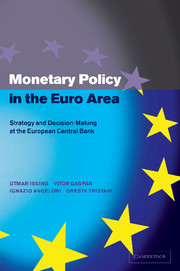Book contents
- Frontmatter
- Contents
- List of figures
- List of tables
- Acknowledgements
- Introduction
- 1 Money, output and prices: the scope of monetary policy
- 2 Monetary policy making: strategies and rules
- 3 The euro area: an overview
- 4 The ECB strategy: defining price stability
- 5 The role of money
- 6 A broadly based assessment
- 7 The ECB strategy: an overall view
- 8 The operational framework
- 9 Accountability and transparency
- 10 The single monetary policy in 1999
- Appendix Excerpts from ECB external communications to the press
- References
- Index
5 - The role of money
Published online by Cambridge University Press: 22 September 2009
- Frontmatter
- Contents
- List of figures
- List of tables
- Acknowledgements
- Introduction
- 1 Money, output and prices: the scope of monetary policy
- 2 Monetary policy making: strategies and rules
- 3 The euro area: an overview
- 4 The ECB strategy: defining price stability
- 5 The role of money
- 6 A broadly based assessment
- 7 The ECB strategy: an overall view
- 8 The operational framework
- 9 Accountability and transparency
- 10 The single monetary policy in 1999
- Appendix Excerpts from ECB external communications to the press
- References
- Index
Summary
The focus of this chapter is the role played, in the ECB strategy, by monetary analysis, and by the related ‘reference value’ announced for the monetary aggregate M3. A special role for money, within a full-information framework, is a distinguishing feature of the ECB strategy. We attempt, in this chapter, to clarify the arguments that, in our view, make such a role necessary. This is an area where economic theory, data evidence and policy experience are closely interrelated: money, as we discussed earlier, plays a central role in all well-established theories of inflation; the international evidence confirms these theories, showing a long run link between money and prices; finally, many central banks in recent economic history, particularly when facing inflationary pressures that they were determined to resist, have placed money at the centre of their monetary policy frameworks.
The chapter is organised as follows. First, drawing on the review of the literature presented in earlier chapters, we summarise the main concepts and evidence that suggest that money has a natural role in any monetary policy strategy aiming at price stability. At the same time, however, we underscore a number of caveats that suggest caution in interpreting and using monetary data for policy purposes. From this we draw some general implications, moving then to a detailed description of the role that money actually plays in the ECB strategy.
- Type
- Chapter
- Information
- Monetary Policy in the Euro AreaStrategy and Decision-Making at the European Central Bank, pp. 76 - 89Publisher: Cambridge University PressPrint publication year: 2001



